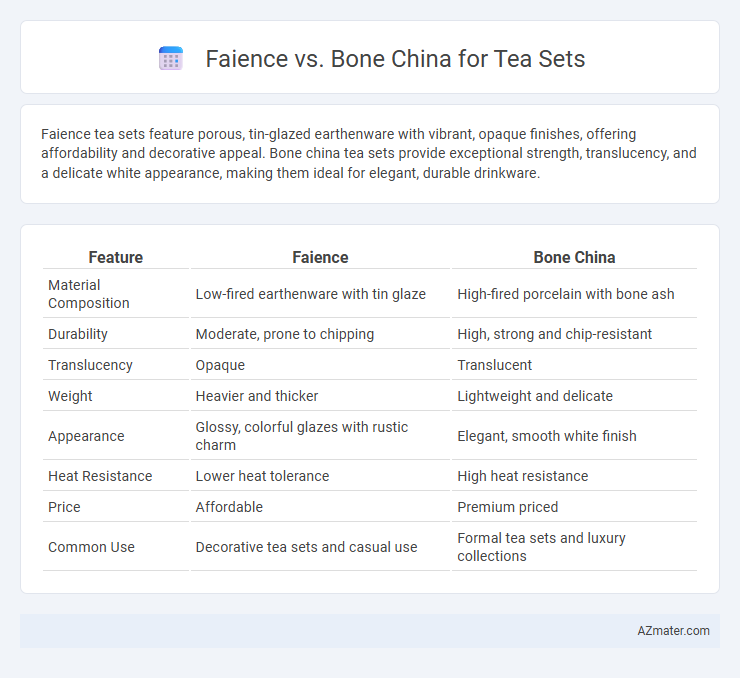Faience tea sets feature porous, tin-glazed earthenware with vibrant, opaque finishes, offering affordability and decorative appeal. Bone china tea sets provide exceptional strength, translucency, and a delicate white appearance, making them ideal for elegant, durable drinkware.
Table of Comparison
| Feature | Faience | Bone China |
|---|---|---|
| Material Composition | Low-fired earthenware with tin glaze | High-fired porcelain with bone ash |
| Durability | Moderate, prone to chipping | High, strong and chip-resistant |
| Translucency | Opaque | Translucent |
| Weight | Heavier and thicker | Lightweight and delicate |
| Appearance | Glossy, colorful glazes with rustic charm | Elegant, smooth white finish |
| Heat Resistance | Lower heat tolerance | High heat resistance |
| Price | Affordable | Premium priced |
| Common Use | Decorative tea sets and casual use | Formal tea sets and luxury collections |
Introduction to Faience and Bone China
Faience is a type of tin-glazed pottery known for its bright, opaque surface and intricate hand-painted designs, typically produced in earthenware form. Bone china, crafted from a mixture of bone ash, feldspathic material, and kaolin, is highly prized for its strength, translucency, and delicate, smooth texture. Both materials offer unique aesthetic and functional qualities, with faience showcasing vibrant colors and rustic charm, while bone china provides a refined, elegant finish ideal for fine tea sets.
Historical Background of Faience and Bone China
Faience originated in ancient Egypt and Mesopotamia around 4000 BCE, characterized by its tin-glazed earthenware that became popular throughout Europe during the Renaissance for its vibrant colors and intricate designs. Bone China was developed in 18th-century England by combining bone ash, feldspathic material, and kaolin to create a strong, translucent porcelain favored for its delicate, elegant appearance. Both materials reflect distinct historical craftsmanship traditions, with Faience representing early ceramic glazing techniques and Bone China embodying innovations in porcelain manufacturing.
Material Composition and Manufacturing Processes
Faience tea sets are crafted from tin-glazed earthenware, featuring a porous ceramic body coated with a bright, opaque glaze that gives a rustic and colorful finish. Bone China combines bone ash, kaolin, and feldspar, creating a translucent, strong, and lightweight ceramic known for its delicate appearance and high durability. Manufacturing Faience involves hand-painting on the glazed surface before firing, while Bone China requires high-temperature firing that vitrifies the bone ash mixture, resulting in a smooth and chip-resistant surface ideal for fine tea sets.
Appearance and Aesthetic Differences
Faience tea sets typically feature vibrant, hand-painted designs with a rustic, matte glaze, showcasing bold colors and intricate patterns inspired by traditional European pottery. Bone China tea sets exhibit a translucent, delicate appearance with a smooth, glossy finish and often incorporate elegant floral or minimalist motifs, emphasizing luxury and refinement. The visual contrast lies in faience's earthy, artisanal charm versus bone china's refined, sophisticated elegance.
Durability and Strength Comparison
Faience tea sets, made from glazed earthenware, offer moderate durability but are more prone to chipping and cracking compared to bone china. Bone china, composed of bone ash, feldspathic material, and kaolin, features superior strength and resistance to breakage, making it ideal for daily use. The high alumina content in bone china enhances its toughness and chip resistance, providing a longer-lasting tea set compared to faience.
Heat Retention and Functionality for Tea
Faience tea sets, made from glazed earthenware, generally have thicker walls that offer moderate heat retention, keeping tea warm longer but often at the expense of a heavier feel and less delicate design. Bone china tea sets excel in heat retention due to their fine, dense composition enriched with bone ash, which maintains tea temperature effectively while providing a lightweight, elegant experience. Functionality-wise, bone china's strength and chip resistance make it ideal for daily use, whereas faience is better suited for decorative or occasional use due to its porous nature and susceptibility to thermal shock.
Price Range and Accessibility
Faience tea sets typically fall within a more affordable price range, making them accessible for everyday use and casual collectors due to their ceramic composition and simpler glazing techniques. Bone china, known for its durability and translucent quality, commands higher prices reflecting its refined craftsmanship, often appealing to luxury buyers or serious collectors. Availability of faience sets is widespread in local markets and online retailers, whereas bone china tea sets are generally found through specialty stores or high-end outlets, impacting accessibility.
Collectability and Value Over Time
Bone china tea sets are highly collectible due to their fine translucency, durability, and association with luxury brands, often appreciating in value over time, especially vintage or limited-edition pieces. Faience tea sets, characterized by their tin-glazed earthenware and vibrant decorative motifs, offer unique cultural and historical appeal but generally hold less market value and slower appreciation compared to bone china. Collectors favor bone china for long-term investment due to its superior material quality and brand prestige, while faience attracts those interested in artisan craftsmanship and regional heritage.
Environmental and Ethical Considerations
Faience tea sets are made from clay fired at low temperatures, which typically uses less energy and results in lower carbon emissions compared to the high-temperature firing required for bone china. Bone china production involves animal bone ash, raising ethical concerns for vegans and those opposed to animal-derived materials, while faience is entirely ceramic-based and plant-friendly. Choosing faience supports more sustainable sourcing and cruelty-free manufacturing, making it a preferable option for environmentally and ethically conscious consumers.
Choosing the Best Option for Your Tea Set
Faience offers a rustic charm with its glazed earthenware and vibrant patterns, making it ideal for casual or decorative tea sets. Bone china, renowned for its translucency, strength, and elegant finish, suits formal tea occasions and collectors seeking durability and sophistication. Choosing between faience and bone china depends on whether you prioritize aesthetic variety and affordability or refined elegance and long-lasting quality in your tea set.

Infographic: Faience vs Bone China for Tea Set
 azmater.com
azmater.com